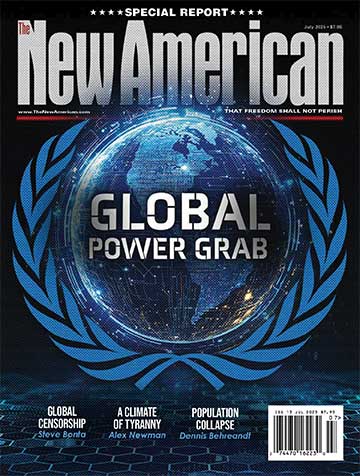It’s the last straw — or at least it should be for freedom lovers. While Washington, D.C., is the nation’s 16th most dangerous city, has the highest rate of cocaine use and the 49th worst schools, the local government is right on top of its biggest problem: single use plastic straws. In fact, the municipality will now penalize not just businesses, but also churches and other non-profits, if they hand out plastic straws or stirrers with beverages — this includes with free coffee offered as charity.
As the Washington Free Beacon reports:
“DOEE will begin inspecting businesses for compliance with the District’s single-use straw and stirrer requirements on January 1st, 2019,” the department said. “DOEE will issue fines for violations of the ban on single-use plastic straws and stirrers beginning July 1, 2019. DOEE is currently assisting regulated entities with achieving compliance through outreach and education.”
The District also is asking residents to report businesses or churches to the government if they hand out free straws or coffee stirrers.
“DOEE solicits tips from the public and conducts regular inspections,” the department said. “After the period of compliance assistance has ended for the compostable and recyclable food service ware requirements, DOEE may issue warnings and fines for violations.”
If this were a comedy about a dystopian future, one could envision government agents hauling away a silver-haired church-lady volunteer as she desperately clings to her straw, her white knuckles bearing witness to the indomitable human spirit. But an actual provision of the D.C. law fits right in with such comedy, as the Beacon also informs that “businesses, churches, and nonprofits can hand out straws and coffee stirrers if they are made from hay.” Please alert Mr. Ed.
Actually, a D.C. government enforcement flyer also mentions that straws may be made out of stainless steel or bamboo as well. Bamboo? Where are we? Myanmar?
It’s more like the Twilight Zone, really. This D.C. Follies folderol is just the latest move in the war on plastic, an effort that has seen killjoy party poopers even start banning balloons.
But let’s burst their bubble. While this all grows out of a commendable desire to reduce the plastic waste in oceans — which does kill marine life — none of these measures will do anything in that regard. Why?
Because only about one percent of plastics in the ocean are from the United States. Our nation and Europe combined account for a mere two percent.
Moreover, while some municipalities and “green” businesses have banned/phased out plastic straws, they constitute only a tiny fraction of that one percent.
The straw obsession is latest virtue-signaling cause, just as “carbon-polluting” SUVs and the desire to save trees — which was the justification in the ‘70s for switching from paper to plastic bags — once were. It’s the childlike phenomenon of impulsively flitting from one concern to another.
Thus is it ironic that activists’ (incorrect) claim that Americans use 500 million plastic straws daily isn’t based on a credible study, but on a nine-year-old’s school project (seriously). And leftists accuse conservatives of being unscientific.
For the record, I take a back seat to no one on this issue, having written in 2007 already about the Great Pacific Garbage Patch, a massive accumulation of floating debris said to be 80 percent plastics and twice the size of Texas. (So, no, not everything is bigger in Texas.)
Yet I also know something else. It certainly is counterintuitive that the economically powerful West, with its conspicuous consumption, wouldn’t be a culprit in this problem. Yet the reality is that, as I wrote in September, the
World Economic Forum reported in June that “just 10 river systems carry 90% of the plastic that ends up in the ocean.”
“Eight of them are in Asia: the Yangtze; Indus; Yellow; Hai He; Ganges; Pearl; Amur; Mekong; and two in Africa — the Nile and the Niger,” the site continues.
Moreover, CNBC informed in 2016 that the environmentalist group the “Ocean Conservancy said in a report … that 60 percent of the plastic trash flowing into the sea originates from China, Vietnam, Philippines, Indonesia, and Thailand” (video below).
Explanation? Unlike the West, these nations are relatively poor and have wanting waste management systems, so much garbage ends up in waterways. Just watch the video below about Indonesia’s Citarum, said to be the world’s most polluted river.
Have you ever seen a U.S. river in such a state, with water and banks clogged with plastics?
Now here’s a piece on the Yamuna, said to be India’s most polluted river:
Having said this, what of the one percent of ocean plastics for which our nation is responsible? The good news (and bad news for some) is that you don’t have to feel guilty about using plastics. They only end up in waterways when people litter; then they can be washed into storm drains, which can empty into rivers, which in turn feed into the ocean. You aren’t part of this problem if you dispose of waste properly.
In fact, contrary to conventional pseudo-wisdom, the problem isn’t that Third World nations are “becoming like us” — it’s that they’re not doing so fast enough. The economically freest countries (Western ones) are not just the richest, but also the cleanest.
The United States is a good example, too. Not only is our water and air cleaner than it was 50 years back, but we now have approximately one-third more forested land than there was a century ago. Moreover, if there is a solution to the problem of ocean-borne plastics — such as biodegradable plastic or plastic-eating bacteria — it will likely be the technologically advanced West’s handiwork.
Of course, this is less likely to happen if we listen to nine-year-olds and prioritize posturing and political correctness over principle and scientific correctness.
Correction: This article originally said that the United States has three times more forest than a century ago. The study cited states that the forests are expanding at three times the rate that they were in the 1920s.
Photo: Vichai/iStock/Getty Images Plus




